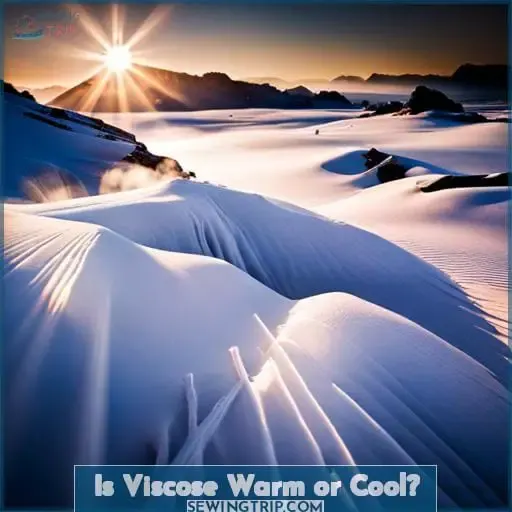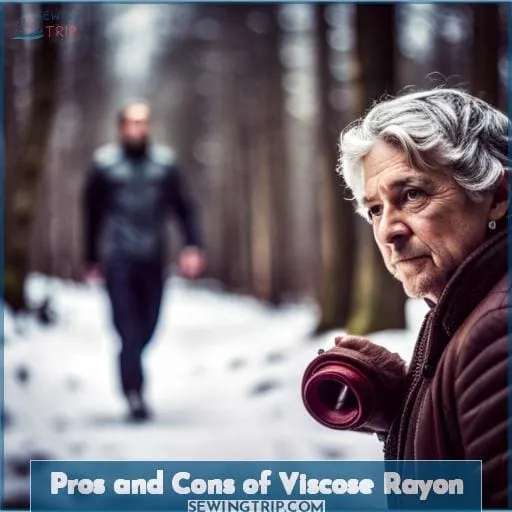This site is supported by our readers. We may earn a commission, at no cost to you, if you purchase through links.
 Are you looking for a fabric that will keep you warm without making you break out in sweat? Then look no further than viscose rayon! So soft yet so powerful, this fabric is the epitome of comfort. But is it truly warm enough to wear during winter months? To answer this question once and for all, let’s dive into the depths of the viscose production process, its pros and cons, as well as how it compares to other fabrics in keeping us cozy.
Are you looking for a fabric that will keep you warm without making you break out in sweat? Then look no further than viscose rayon! So soft yet so powerful, this fabric is the epitome of comfort. But is it truly warm enough to wear during winter months? To answer this question once and for all, let’s dive into the depths of the viscose production process, its pros and cons, as well as how it compares to other fabrics in keeping us cozy.
Viscose is made from cellulose fibers derived from wood pulp or cotton. The pulp is dissolved in chemicals to make a viscous solution that is then extruded through tiny holes into an acidic bath.
The benefits of viscose are that it’s breathable, soft, drapes nicely, and absorbs moisture well. The cons are that it wrinkles easily, can shrink, and is not as durable as natural fibers.
Compared to cotton, viscose is not as breathable or moisture-wicking. However, it is softer, more drapey, and often cheaper. Viscose also lacks the insulation of wool but feels smoother against the skin. While not as warm as wool or fleece, viscose layers well and provides moderate warmth.
So in summary, viscose rayon makes a good cool weather fabric, providing more warmth than cotton but less than wool. With proper layering, viscose can keep you cozy through winter while remaining lightweight and comfortable against the skin.
Table Of Contents
Key Takeaways
- Viscose is not as warm as wool but provides moderate warmth suitable for cool weather when layered.
- It is more breathable and absorbs moisture better than cotton does.
- Blends of viscose with other fibers can enhance warmth and moisture management capabilities.
- For better winter insulation, consider switching to other fabrics like wool, cashmere, silk, or fleece instead.
Is Viscose Warm or Cool?
Viscose is more breathable than polyester and warmer than cotton, striking the perfect balance between the two. It has moderate insulation properties, making it a great choice for temperate weather. In summer, its breathability helps moisture evaporate quickly, keeping you cooler.
Yet in spring and fall, it provides more warmth than a light cotton fabric would.
Viscose is versatile for layering too. You can combine it with cotton or linen when extra warmth is needed, or wear it alone once the weather warms up. Its absorbency and texture give viscose a liveliness and comfort that work across seasons.
While less insulating than wool, viscose has enough substance for transitional weather, and none of wool’s itchiness.
For a fabric embracing both cool-weather coziness and warm-weather breathability, look no further than the soft versatility of viscose.
Which is Warmer Viscose or Polyester?
Though often lightweight, viscose garments tend to be warmer than polyester ones, don’t they? When it comes to staying cozy in cooler weather, viscose has some distinct advantages over polyester. The natural feel of viscose on your skin provides more warmth than the synthetic polyester fabric.
Viscose absorbs moisture better as well, capturing your body heat instead of letting it escape.
So while polyester resists wrinkles and is easy to wash, a viscose sweater or thermal will keep you snug when temperatures drop. For retaining warmth in winter, traditional wool still reigns supreme of course.
Yet with viscose’s breathability and softness, it makes the ideal material for layering underneath heavier wool coats and jackets.
Choosing the right fabrics for each season is an art – but you can trust viscose to provide comforting warmth as the weather cools down.
Is Viscose Warmer Than Cotton?
Closer, but more breathable.
When comparing viscose and cotton for warmth, both have their advantages, though viscose edges out cotton in some key areas:
Viscose is more breathable than cotton, allowing heat and moisture to dissipate. Cotton traps heat and can feel heavy, while viscose feels lightweight year-round. Viscose absorbs moisture better than cotton, keeping you dryer. The smooth surface of viscose doesn’t hold heat like cotton’s textured weave.
For winter wear, viscose works nicely as a base layer to wick moisture, or a middle layer for lightweight warmth. But for real cold weather insulation, look to wool, down, or thick cotton fabrics instead.
Although close in warmth, viscose’s better breathability makes it a winner over cotton for staying cozy in cool weather without overheating.
Is Viscose Warmer Than Wool?
When it comes to warmth, viscose and wool are worlds apart. Wool has natural insulating properties that trap heat and keep you cozy even on the chilliest winter days. Its crimped fibers form tiny pockets that hold warm air close to your skin. Viscose, on the other hand, offers minimal insulation.
Without wool’s special structure, viscose fabrics feel lightweight and breezy. They can’t protect you from frigid temperatures like wool can.
So while viscose works beautifully for flowy blouses and airy dresses, it’s too light and breathable for true cold weather wear. Stick to wool coats, sweaters, and accessories if you want to stay toasty warm. Viscose may excel at many things, but insulation isn’t one of them.
Is Viscose Blend Warm?
Seems viscose blends with other fibers can keep ya cozy when it’s brisk out. Though viscose has natural breathability, it lacks warmth on its own. But paired with wool, polyester or even cotton, it makes a versatile fabric that insulates against chill while managing moisture.
The fiber ratio impacts blend warmth – more wool or poly means more toastiness. With breathable viscose, sweat don’t linger. For lightweight insulation, a viscose/poly or viscose/cotton blend layers smoothly under outerwear.
A touch of viscose adds softness, wicking and flexibility to wool for comfy sweaters and turtlenecks without the itch. Adjust the blend to balance insulation, stretch and softness for the coverage ya need.
Blended well, viscose joins powers with other fibers for adaptable cold-weather comfort.
Can Viscose Keep You Warm?
- Layer a thermal or wool undershirt underneath your viscose top. The extra insulation will trap heat.
- Wear thick, opaque tights or leggings under viscose pants or skirts. This blocks any cold air from reaching your skin.
- Add a cardigan, jacket or coat on top of your viscose dress or blouse. Having an outer layer helps lock in body heat.
- Slip on warm socks and closed-toe shoes, boots or booties. This protects your extremities from the cold.
- Drink something warm like tea, coffee or hot chocolate. The heat from the inside will radiate outwards.
Viscose’s breathability makes it ideal for warmer weather, but with smart layering and accessories you can stay cozy even when temperatures dip. Focus on coverage and insulation under and over your viscose pieces. Trapping heat is key for warmth, regardless of the fabric.
Is Viscose Warm Enough for Winter?
Although viscose may seem lightweight, it can work for winter if you layer strategically. With the right base layers, a viscose sweater or shirt offers breathability. Viscose wicks moisture better than cotton, so pairing it with wool undershirts and leggings prevents clamminess.
For extra insulation, wear a fleece or down vest underneath your viscose top. Thermal socks, thick tights and a scarf boost warmth too.
With the right layers, viscose lets you bundle up without overheating. For frigid temps, however, swap the viscose for wool, fleece or down. Viscose shines in fall and milder winter climates. Take advantage of its versatility – just be mindful of layering for true winter days.
Viscose Production Process
You might want to start exploring other breathable fabrics that are better suited for the cold winter months ahead. Viscose tends to be quite lightweight and may not provide enough warmth and insulation when temperatures really start to drop.
The viscose production process involves:
- Cellulose extraction from wood pulp or cotton linters
- Chemical treatment to produce soluble cellulose xanthate
- The regeneration process to form viscose filaments
- Initiatives for more sustainable practices and clean production
Though a versatile fabric, viscose may lack the warmth you’ll need in winter. Look into wool, cashmere, silk, or synthetics like fleece that provide better insulation. With some research into materials, you can stay stylish and comfortable when the weather turns cold.
Pros and Cons of Viscose Rayon
Viscose breathes easy, so it’s perfect for summer shirts ‘n shorts. But it’s got its ups and downs.
Viscose is crazy breathable, absorbing moisture and keeping ya cool. It drapes like a dream, following your body’s natural curves. The feel is silky soft too. But it does wrinkle like an old geezer’s face. Heat and humidity make it droop faster than a wet noodle.
Eco-wise, traditional viscose production’s a dirty biz. But new closed-loop technologies are cleaning it up.
The choice is yours: Does supple drape and breezy comfort outweigh fussier care? For summer, viscose’s light and airy.
Different threads for different needs.
Conclusion
The old saying goes, clothing makes the man. When it comes to comfort and warmth, it’s key to choose fabrics wisely. Viscose rayon is versatile; it’s not fully natural or synthetic, making it okay for warm weather.
While it’s lightweight, strong, and soft, it’s not as warm as cotton or wool. Viscose blend fabrics can offer some extra warmth, but wool’s better for winter.
Ultimately, whether you choose viscose or not, know its characteristics and sustainability to make informed fabric choices.















